 |
| |
Switch to: Europe, USA, New Zealand, Antarctica
Credit: NOAA/Ovation
 Planetary K-index
Planetary K-index
Now: Kp=
1.00 quiet
24-hr max: Kp= 1.67 quiet
explanation | more
data
Interplanetary Mag. Field
Btotal: 7.33 nT
Bz: 0.80 nT north
more data: ACE, DSCOVR
Updated: Today at 0921 UT
 Coronal Holes: 27 Aug 25
Coronal Holes: 27 Aug 25
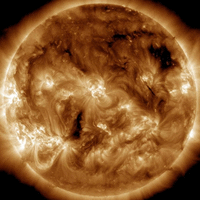
There are no equatorial coronal holes on the Earthside of the sun. Credit: NASA/SDO | more data

Polar Stratospheric Clouds
Colorful Type II polar stratospheric clouds (PSC) form when the temperature in the stratosphere drops to a staggeringly low -85C. NASA's MERRA-2 climate model predicts when the air up there is cold enough:
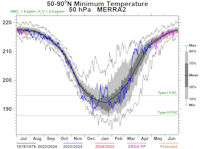
On Aug 27, 2025, the Arctic stratosphere is much too hot for polar stratospheric clouds. | more data.
Noctilucent Clouds
The northern season for noctilucent clouds is underway. First reports of the electric-blue clouds came from Russia on May 28, 2025. Since then, the clouds have spread to lower latitudes, reaching Paris, France, during a major outbreak on June 23, 2025. The seson is ending in an interesting way. Usually the clouds vanish in August, but they have persisted and sometimes been quite storng as August comes to an end.

Above: Aug. 21, 2025, Björköby, Finland
"These late season noctilucent clouds drifted in front of the crescent moon. It was quite beautiful," says photographer Sebastian Sainio.
See the complete NLC Photo Gallery

SPACE WEATHER
NOAA Forecasts |
|
Updated at: 2025 Aug 26 2200 UTC
FLARE |
0-24
hr |
24-48
hr |
CLASS M |
60
% |
60
% |
CLASS X |
10
% |
10
% |
 Geomagnetic Storms:
Geomagnetic Storms:
Probabilities for significant
disturbances in Earth's magnetic field are given for three activity levels: active, minor
storm, severe
storm
Updated at: 2025 Aug 26 2200 UTC
Mid-latitudes
|
0-24
hr |
24-48
hr |
ACTIVE |
25
% |
20
% |
MINOR |
10
% |
05
% |
SEVERE |
01
% |
01
% |
High latitudes
|
0-24
hr |
24-48
hr |
ACTIVE |
15
% |
15
% |
MINOR |
30
% |
30
% |
SEVERE |
40
% |
25
% |
|
|
|
 |
|
|
|
| |
|
|
|
| |
This is an AI Free Zone: Text created by Large Language Models is spreading across the Internet. It's well-written, but frequently inaccurate. If you find a mistake on Spaceweather.com, rest assured it was made by a real human being.
|
|
|
STARSHIP 10 LAUNCH SUCCESS: First, Starship 10 didn't explode. Then, it accomplished almost all of its mission objectives. SpaceX's massive Starship, combined with its Super Heavy booster, lifted off from Starbase, Texas on Aug. 26th at 6:30 PM CDT. For the first time, Starship successfully deployed eight extra-large Starlink satellite simulators into orbit, paving the way for future expansion of the megaconstellation. Then it landed (a soft splashdown) in the Indian Ocean. [Launch Video] [Landing Video]
IS 3I/ATLAS REALLY A COMET? The most intriguing mystery in astronomy today is the nature of interstellar object 3I/ATLAS. Most astronomers believe it is a comet. However, iconoclast Avi Loeb of Harvard University makes the case that it might be something else--like alien tech.
Into this debate comes new data from the James Webb Space Telescope. A paper just submitted to the Astrophysical Journal Letters reports that 3I/ATLAS looks like a comet, albeit a strange one. Here are the images from JWST:
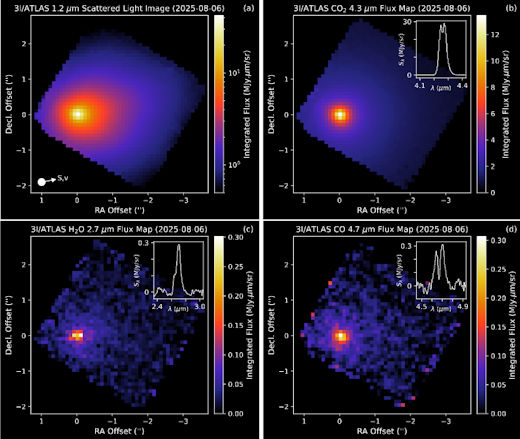
Above: These JWST images show the distribution of carbon dioxide (panel b), water (panel c) and carbon monoxide (panel d). Most of the light is coming from CO2.
The infrared space telescope found most of the ingredients we expect to find in comets. There's a fuzzy coma, volatile ices, and all the usual molecules: water (H20), carbon dioxide (CO2), carbon monoxide (CO). If 3I/ATLAS is a spacecraft, it has an uncanny disguise.
However, there's also something strange. The ratios of the different molecules are quite unexpected and don't match what we see in Solar System comets. In particular, the CO2/H20 ratio of 8 ± 1 is extremely high. Only one other comet, C/2016 R2, is known to have similar chemistry, and astronomers have long considered it to be a "freak."
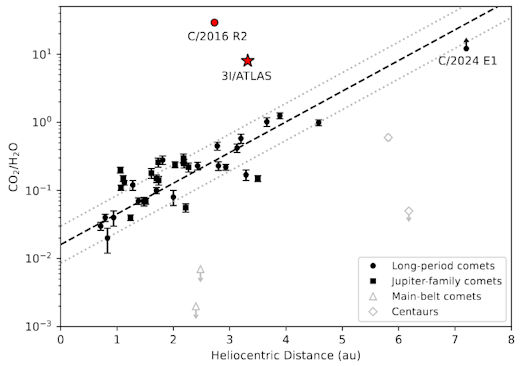
Above: Carbon dioxide-to-water ratios in known comets. 3I/ATLAS does not fit the trend.
Typical comets have a lot more water in their atmospheres, with H20 almost always outnumbering CO2. It could be that water production in 3I/ATLAS has not yet fully "turned on" because it is still too cold. If so, solar heating could restore ratios to normal. 3I/ATLAS will reach its closest point to the sun (1.36 AU) on Oct. 29, 2025, potentially bringing forth a geyser of water vapor to mix with the other gases.
Or, maybe, 3I/ATLAS is just strange--like it came from another star system. Stay tuned for updates.
Realtime Space Weather Photo Gallery
Free: Spaceweather.com Newsletter
LITTLE GREEN SANTA ORNAMENT: You can't buy this on Amazon: The Little Green Santa Christmas Ornamant is only available from the Earth to Sky Store. On Aug. 22, 2025, it flew to the stratosphere onboard a cosmic ray research balloon:

You can have it for $99.95. Hand-sculpted in the USA, this humorous ornament shows Santa arriving from the North Pole of a distant planet. Durable polyresin construction makes it lightweight enough to hang on any tree, but sturdy enough to last for many Christmases to come.
The students are selling space ornaments to pay the helium bill for their cosmic ray ballooning program. Each one comes with a greeting card showing the ornament in flight and telling the story of its trip to the stratosphere and back again.
Far Out Gifts: Earth to Sky Store
All sales support hands-on STEM education
Realtime Noctilucent Cloud Photo Gallery
Free: Spaceweather.com Newsletter
Realtime Aurora Photo Gallery
Free: Spaceweather.com Newsletter
Every night, a network
of NASA
all-sky cameras scans the skies above the United
States for meteoritic fireballs. Automated software
maintained by NASA's Meteoroid Environment Office
calculates their orbits, velocity, penetration depth
in Earth's atmosphere and many other characteristics.
Daily results are presented here on Spaceweather.com.
On Aug 26, 2025, the network reported 10 fireballs.
(9 sporadics, 1 kappa Cygnid)

In this diagram of the inner solar system, all of the fireball orbits intersect at a single point--Earth. The orbits are color-coded by velocity, from slow (red) to fast (blue).
[Larger image] [movies]
Potentially Hazardous Asteroids ( PHAs)
are space rocks larger than approximately 100m that
can come closer to Earth than 0.05 AU. None of the
known PHAs is on a collision course with our planet,
although astronomers are finding new
ones all the time.
On August 27, 2025 there were 2349 potentially hazardous asteroids.
 |
Recent
& Upcoming Earth-asteroid encounters:
| Asteroid |
Date(UT) |
Miss Distance |
Velocity (km/s) |
Diameter (m) |
| 2025 OB3 |
2025-Aug-21 |
8.8 LD |
7 |
50 |
| 2025 QM3 |
2025-Aug-21 |
0.5 LD |
9.2 |
6 |
| 2025 QU4 |
2025-Aug-21 |
11 LD |
18.4 |
25 |
| 2025 QU5 |
2025-Aug-21 |
1.1 LD |
9 |
7 |
| 2025 PN2 |
2025-Aug-21 |
9.9 LD |
16.6 |
31 |
| 2022 QD3 |
2025-Aug-21 |
15.4 LD |
6.9 |
35 |
| 2025 QB4 |
2025-Aug-22 |
2 LD |
13.7 |
8 |
| 2025 QV4 |
2025-Aug-22 |
4.2 LD |
16.7 |
32 |
| 2025 QY |
2025-Aug-22 |
7.5 LD |
7.8 |
15 |
| 2023 PX |
2025-Aug-22 |
2.4 LD |
8.3 |
23 |
| 2025 QE4 |
2025-Aug-22 |
1.3 LD |
6.4 |
10 |
| 2025 QE2 |
2025-Aug-22 |
17.1 LD |
7.2 |
35 |
| 2025 QA5 |
2025-Aug-23 |
2.6 LD |
8 |
10 |
| 2025 PR |
2025-Aug-23 |
17.6 LD |
3.4 |
22 |
| 2025 QF4 |
2025-Aug-23 |
4.2 LD |
10.7 |
12 |
| 2019 QQ6 |
2025-Aug-24 |
9.4 LD |
17.2 |
31 |
| 2025 QV3 |
2025-Aug-25 |
9.9 LD |
6.2 |
11 |
| 2025 QB3 |
2025-Aug-26 |
19.1 LD |
7 |
21 |
| 2025 QK3 |
2025-Aug-26 |
11.7 LD |
12.7 |
37 |
| 2025 QB5 |
2025-Aug-26 |
11.7 LD |
4.8 |
26 |
| 2025 QC1 |
2025-Aug-27 |
4.2 LD |
9.4 |
21 |
| 2025 PM2 |
2025-Aug-27 |
9.7 LD |
18.5 |
59 |
| 2025 QX4 |
2025-Aug-27 |
3.7 LD |
6.9 |
24 |
| 2025 PX |
2025-Aug-29 |
16.5 LD |
7 |
53 |
| 2025 QY4 |
2025-Aug-29 |
11.8 LD |
13.5 |
57 |
| 2017 RK15 |
2025-Aug-29 |
15.8 LD |
13.2 |
26 |
| 2020 TS1 |
2025-Aug-29 |
17.8 LD |
3.3 |
5 |
| 1998 SH2 |
2025-Aug-30 |
8.1 LD |
17.3 |
246 |
| 2025 QK6 |
2025-Aug-30 |
2.8 LD |
21.5 |
15 |
| 2025 PJ3 |
2025-Sep-01 |
7.9 LD |
11.7 |
30 |
| 2025 QV5 |
2025-Sep-03 |
2.1 LD |
6.2 |
13 |
| 2025 QM6 |
2025-Sep-03 |
11 LD |
10.1 |
54 |
| 2025 PF3 |
2025-Sep-03 |
16.3 LD |
6.9 |
22 |
| 2025 OG1 |
2025-Sep-05 |
14.5 LD |
4.2 |
35 |
| 2019 JG1 |
2025-Sep-09 |
18.8 LD |
7.9 |
17 |
| 2009 FF |
2025-Sep-11 |
6.8 LD |
12.9 |
155 |
| 2025 QO1 |
2025-Sep-11 |
8.7 LD |
13.6 |
82 |
| 2015 SA |
2025-Sep-13 |
10.3 LD |
9.1 |
31 |
| 2022 SS2 |
2025-Sep-13 |
2.4 LD |
7.2 |
13 |
| 2025 QR1 |
2025-Sep-14 |
19.7 LD |
8.7 |
160 |
| 2025 FA22 |
2025-Sep-18 |
2.2 LD |
10.8 |
166 |
| 2025 PJ1 |
2025-Sep-21 |
11.6 LD |
11.9 |
131 |
| 2022 SW12 |
2025-Sep-23 |
15 LD |
17.6 |
210 |
| 2018 QT1 |
2025-Sep-23 |
13.1 LD |
12.7 |
138 |
| 2021 RN16 |
2025-Sep-23 |
10.1 LD |
8.8 |
7 |
| 2019 SF6 |
2025-Sep-28 |
20 LD |
8.4 |
20 |
| 152664 |
2025-Sep-29 |
10.1 LD |
18.6 |
412 |
| 2020 GE1 |
2025-Oct-02 |
13.7 LD |
4.7 |
14 |
| 2022 TU1 |
2025-Oct-08 |
16.9 LD |
12.9 |
10 |
| 2020 QU5 |
2025-Oct-09 |
7.1 LD |
13.6 |
26 |
| 2022 AY5 |
2025-Oct-14 |
7.4 LD |
8.4 |
5 |
| 2022 UY3 |
2025-Oct-15 |
10.2 LD |
7.4 |
15 |
| 2022 UU15 |
2025-Oct-19 |
14.8 LD |
16.1 |
34 |
| 2023 UK3 |
2025-Oct-21 |
6.7 LD |
9 |
5 |
| 2024 GD2 |
2025-Oct-22 |
17.8 LD |
4.2 |
28 |
| 2022 HM1 |
2025-Oct-23 |
15.1 LD |
13.3 |
27 |
Notes: LD means
"Lunar Distance." 1 LD = 384,401 km, the distance
between Earth and the Moon. 1 LD also equals 0.00256
AU.
| |
Cosmic Rays in the Atmosphere |
SPACE WEATHER BALLOON DATA: Almost once a week, Spaceweather.com and the students of Earth to Sky Calculus fly space weather balloons to the stratosphere over California. These balloons are equipped with sensors that detect secondary cosmic rays, a form of radiation from space that can penetrate all the way down to Earth's surface. Our monitoring program has been underway without interruption for 10 years, resulting in a unique dataset of in situ atmospheric measurements.
Latest results (Nov. 2024): Atmospheric radiation is sharply decreasing in 2024. Our latest measurements in November registered a 10-year low:
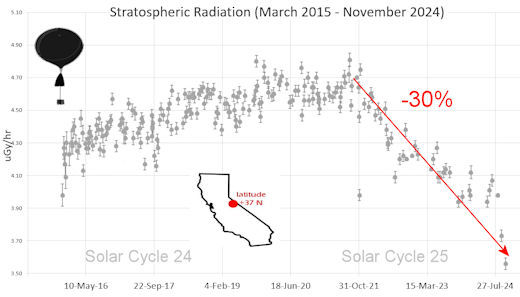
What's going on? Ironically, the radiation drop is caused by increasing solar activity. Solar Cycle 25 has roared to life faster than forecasters expected. The sun's strengthening and increasingly tangled magnetic field repels cosmic rays from deep space. In addition, solar coronal mass ejections (CMEs) sweep aside cosmic rays, causing sharp reductions called "Forbush Decreases." The two effects blend together to bring daily radiation levels down.
.Who cares? Cosmic rays are a surprisingly "down to Earth" form of space weather. They can alter the chemistry of the atmosphere, trigger lightning, and penetrate commercial airplanes. According to a study from the Harvard T.H. Chan school of public health, crews of aircraft have higher rates of cancer than the general population. The researchers listed cosmic rays, irregular sleep habits, and chemical contaminants as leading risk factors. A number of controversial studies (#1, #2, #3, #4) go even further, linking cosmic rays with cardiac arrhythmias and sudden cardiac death.
Technical notes: The radiation sensors onboard our helium balloons detect X-rays and gamma-rays in the energy range 10 keV to 20 MeV. These energies span the range of medical X-ray machines and airport security scanners.
Data points in the graph labeled "Stratospheric Radiation" correspond to the peak of the Regener-Pfotzer maximum, which lies about 67,000 feet above central California. When cosmic rays crash into Earth's atmosphere, they produce a spray of secondary particles that is most intense at the entrance to the stratosphere. Physicists Eric Regener and Georg Pfotzer discovered the maximum using balloons in the 1930s and it is what we are measuring today.
| |
The
official U.S. government space weather bureau |
| |
The
first place to look for information about sundogs,
pillars, rainbows and related phenomena. |
| |
Researchers
call it a "Hubble for the sun." SDO
is the most advanced solar observatory ever. |
| |
3D
views of the sun from NASA's Solar and Terrestrial
Relations Observatory |
| |
Realtime
and archival images of the Sun from SOHO. |
| |
information about sunspots based on the latest NOAA/USAF Active Region Summary |
| |
current counts of failed and deployed Starlink satellites from Jonathan's Space Page. See also, all satellite statistics. |
| |
Authoritative predictions of space junk and satellite re-entries |
| |
from
the NOAA Space Environment Center |
| |
fun to read, but should be taken with a grain of salt! Forecasts looking ahead more than a few days are often wrong. |
| |
from the NOAA Space Environment Center |
| |
the
underlying science of space weather |
 |
Got a chipped or cracked windshield that prevents you from seeing space weather events while driving? Get windshield replacement from SR Windows & Glass with free mobile auto glass service anywhere in the Phoenix area. |
 |
BestCSGOGambling is the best site for everything related to CSGO gambling on the web |
| |
These links help Spaceweather.com stay online. Thank you to our supporters! |
|
|
| |
|
|
|
|
 |
|
 |

 |
©2021 Spaceweather.com. All rights reserved. This site is penned daily by Dr. Tony Phillips. |
|